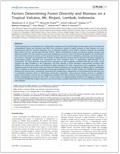| Journal Article |
 |
|
| Article Title | Factors Determining Forest Diversity and Biomass on a Tropical Volcano, Mt. Rinjani, Lombok, Indonesia | | Author | Gbadamassi G. O. Dossa, Ekananda Paudel, Junichi Fujinuma, Yu Haiying, Wanlop Chutipong, Yuan Zhang, Sherryl Paz and Rhett Daniel Harrison | | Year | 2013 | | Journal Title | PLOS ONE | | Institution | Public Library of Science | | Volume | 8 | | Issue | 7 | | Pages | 1-11 | | Call Number | JA0539-14 |
|
| Abstract: |
| Tropical volcanoes are an important but understudied ecosystem, and the relationships between plant species diversity and
compositional change and elevation may differ from mountains created by uplift, because of their younger and more
homogeneous soils. We sampled vegetation over an altitudinal gradient on Mt. Rinjani, Lombok, Indonesia. We modeled
alpha- (plot) and beta- (among plot) diversity (Fisher’s alpha), compositional change, and biomass against elevation and
selected covariates. We also examined community phylogenetic structure across the elevational gradient. We recorded 902
trees and shrubs among 92 species, and 67 species of ground-cover plants. For understorey, subcanopy and canopy plants,
an increase in elevation was associated with a decline in alpha-diversity, whereas data for ground-cover plants suggested a
hump-shaped pattern. Elevation was consistently the most important factor in determining alpha-diversity for all
components. The alpha-diversity of ground-cover vegetation was also negatively correlated with leaf area index, which
suggests low light conditions in the understorey may limit diversity at lower elevations. Beta-diversity increased with
elevation for ground-cover plants and declined at higher elevations for other components of the vegetation. However,
statistical power was low and we could not resolve the relative importance to beta-diversity of different factors. Multivariate
GLMs of variation in community composition among plots explained 67.05%, 27.63%, 18.24%, and 19.80% of the variation
(deviance) for ground-cover, understorey, subcanopy and canopy plants, respectively, and demonstrated that elevation was
a consistently important factor in determining community composition. Above-ground biomass showed no significant
pattern with elevation and was also not significantly associated with alpha-diversity. At lower elevations communities had a
random phylogenetic structure, but from 1600 m communities were phylogenetically clustered. This suggests a greater role
of environmental filtering at higher elevations, and thus provides a possible explanation for the observed decline in diversity
with elevation. |
|